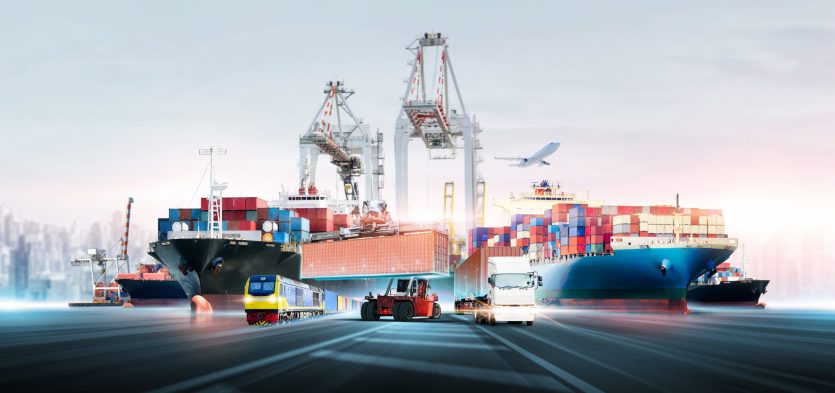5 Ways to Streamline Cross-border Transportation
Over $1 trillion in goods consistently cross the U.S.-Canada and U.S.-Mexico borders annually. And with nearly 30% of all U.S. trade in 2023 conducted with its neighbors to the north and south, streamlining cross-border transportation is crucial. Shippers doing business across North America must be prepared to navigate the complexity and challenges that come with cross-border trade.
Read also: CROSS-BORDER CARGO TRANSPORTATION CHALLENGES AND SOLUTIONS
Growth of North American Trade
The high volume of goods being moved across the northern and southern border is not new. U.S. imports from Canada have increased at an annualized rate of around 4.23% over the last 27 years and reached US $429.6 billion in 2023. Meanwhile, U.S. exports to Canada have increased at an annualized growth rate of 3.69% over that same period, reaching US $352.76 billion in 2023.
Likewise, the value of goods imported to the U.S. from Mexico rose to over US $475 billion in 2023 and imports from Mexico to the U.S. are expected to increase by 30-40% in the next 5 years, especially as interest in nearshoring continues to grow.
While increased trade between the U.S., Mexico and Canada will positively impact businesses and the economy, it brings with it a range of cross-border transportation challenges that shippers must navigate.
Cross-border Transportation Challenges: Customs & Border Procedures
Navigating the complexities of cross-border transportation presents a myriad of challenges for shippers. The first, and most important, are customs and border procedures. From documentation and security inspections to border clearance processes, customs and border crossing procedures can be labor-intensive and intricate for shippers and an intimidating aspect of supply chain operations.
Within this already complicated ecosystem of regulations, different border crossings require different customs procedures. As a result, shippers must know the different requirements and procedures for northbound versus southbound freight, as well as for individual origin terminals. Shippers should not assume the requirements and procedures for transporting goods from the U.S. into Canada are the same as going from Canada to the U.S.; otherwise, they risk having shipments held up at the border.
These complex procedures and requirements make it critical for shippers to have the necessary processes in place. For example, many required documents, such as commercial invoices and USMCA compliant certificate of origin, must be compiled and key shipment data such as the names of the exporter, importer and carrier, points of origin and destination, product weight and size, handling unit, container type for handling unit, piece count on the handling unit, container type for pieces and more must be submitted electronically several hours before a load gets to the border. Submitting pre-arrival information electronically using the Canada Border Services Agency’s (CBSA) eManifest Portal can help streamline the cross-border process but requires shippers and their carrier partners to have processes in place to compile and submit required data in advance.
Complicating matters further, these procedures present a moving target for shippers when they are updated or changed. One recent change to customs procedures impacting shippers is the CBSA’s Assessment and Revenue Management (CARM) project, a multi-year initiative intended to transform the collection of duties and taxes for goods imported into Canada. CARM requires importers to submit documents and make payments through a new system. This puts the onus on the importer to compile and submit the required data and paperwork in advance, which can add additional steps or complexity to shippers’ operations. Technical and integration issues have disrupted operations and caused delays for many shippers.
More Cross-border Transportation Challenges for Shippers
- Regulatory Requirements and Differences: Differences in regulations related to documentation, safety and emission standards, taxes, product certifications, permits, driver hours-of-service and more between the U.S., Canada and Mexico create compliance challenges for shippers, transportation carriers and logistics providers. Goods must not only comply with the regulations and safety standards of the country of origin, but also of those of the receiving country.
- Security Procedures: Strict security measures are in place to reduce the threat of terrorism, smuggling and other illegal activity when shipping goods across the border. This includes customs officials reviewing presented documents and checking any other mandated security requirements. For example, some countries, like the U.S., require security seals to be placed on trailers upon loading to prevent tampering during transit. While countries use random selection for inspections, factors such as suspicious goods, flagged countries of origin, new shippers, etc. can impact which shipments are selected. Depending on the risk assessment, physical inspections may be non-intrusive using X-ray systems or require containers to be opened and verified. These inspections can add obstacles to the shipping process and can cause delays.
- Infrastructure Gaps: Efforts to improve the border crossing process are ongoing, but challenges remain. Varying infrastructure quality, outdated systems, limited staffing, and high traffic volumes at some border crossings create bottlenecks, contributing to delays. The need for better integration between transportation modes also contributes to wasted costs.
Steps to Streamline Cross-border Transportation
Effective cross-border transportation without delays relies on collaboration and coordination among importers, exporters, transportation providers, customs and border authorities, and other stakeholders. While a challenging process, there are steps shippers can take to set themselves up for success. By following these best practices, shippers can navigate the complexities of cross-border shipping and help ensure the smooth transportation of goods across North American borders.
1. Partner with a transportation provider with a proven track record. Choose reliable carriers with experience in cross-border shipping. Look for companies with technology and processes to streamline and simplify cross-border shipping, especially if you select a single provider for end-to-end service. Consider factors such as lanes, terminal locations, transit times, and customer service when selecting carriers.
Utilizing The Customs Self-Assessment Program (CSA) and C-TPAT-certified carriers and Commercial Driver Registration Program (CDRP), drivers can further streamline and reduce the risk of delays or compliance-related issues at the border. For example, carriers with terminals near the Canadian border can carry both CSA-approved and non-CSA approved freight and store freight until it’s cleared without affecting the freight that’s eligible to cross the border. Or if one importer on a trailer didn’t submit their paperwork in advance via the CARM portal, those goods can be stored at the terminal while the rest of the shipment can continue without delay. Additionally, bonded carriers are licensed to move freight through U.S. border crossings without having to pay duties or fees during that segment of transportation, helping further streamline cross-border shipping.
2. Automate the process. Utilizing transportation software and compliance solutions expedites the cross-border shipping process by automating documentation creation and submission while also reducing manual process time and errors. By automating the process, you avoid needing to compile documents from multiple sources. It also ensures all necessary documents, containing complete and accurate information, are available to all stakeholders, when and where they need them.
3. Have a secondary customs broker as a backup. Disruptions within the supply chain, whether due to software glitches, security breaches or transportation providers shutting down operations, can significantly impact a shipper’s business. Just as shippers are diversifying their carrier bases to create more resilient supply chains, having a secondary customs broker in place can help mitigate disruptions if there are issues with a primary broker.
4. Stay informed. Understand how the requirements and procedures for cross-border shipments differ from domestic shipments. Keep up to date with the customs regulations, documentation requirements and duties for both the exporting and importing countries. Confirm you have the proper processes in place to comply with these requirements to avoid costly delays and fines.
5. Ensure complete and accurate shipping documents. Verify all shipping documents, including commercial invoices, customs declarations, bills of lading, certificates of origin, and any necessary permits, are complete and accurate. Errors, discrepancies, or missing paperwork can cause delays and customs clearance problems. Also, make sure the proper shipment data is submitted electronically in advance and is ready for the driver.
Be Proactive with Approach to Cross-border Shipping
As trade between the U.S., Mexico and Canada continues to grow, the need for effective cross-border shipping processes becomes even more crucial. Even if only a small percentage of shipments go to or from Mexico or Canada, shippers must take steps to ensure they’re prepared and shipped properly to avoid disruptions to their supply chain.
Author Bio
Tony Esparza is vice president of strategic operations at Hercules, an award-winning, asset-based motor carrier and customs brokerage, specializing in US-to-Canada, cross-border to and from Mexico, and intra-US shipments.





Leave a Reply